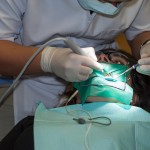
Moisture control during the placement of dental restorations is an important factor in restoration success. Cotton wool rolls an aspiration is the most commonly used approach for moisture control although the use of rubber dam, first introduced in 1864, is also recommended as an alternative. While rubber dam has a number of advantages, better isolation, improved visibility, soft tissue retraction, it also has disadvantages, patient acceptability, application time and material costs etc.
The aim of this Cochrane review was to assess the effects of rubber dam isolation compared with other types of isolation used for direct and indirect restorative treatments in dental patients.
Methods
Searches were conducted in the Cochrane Oral Health’s Trials Register, Cochrane Central Register of Controlled Trials (CENTRAL), Medline, Embase, LILACS, SciELO, Chinese BioMedical Literature Database, VIP, China National Knowledge Infrastructure, ClinicalTrials.gov, World Health Organization International Clinical Trials Registry Platform, OpenGrey and Sciencepaper Online databases. This was supplemented by hand searches in a number of dental journals.
Two reviewers independently selected studies, abstracted data and assessed risk of bias using the Cochrane tool. Randomised controlled trials or quasi-randomised controlled trials (including split-mouth/cross-over studies) conducted in patients undergoing any type of direct or indirect restorative treatment were considered. The primary outcome was Survival rate of the restorations at 6 months, 1, 2, 5 and 10 years after restorative treatments.
Results
- 4 studies involving a total of 1270 patients were included.
- All 4 studies were considered to be at high risk of bias.
- Restorations had a significantly higher survival rate in the rubber dam isolation group compared to the cotton roll isolation group at 6 months in patients receiving composite restorative treatment of non-carious cervical lesions, risk ratio (RR) =1.19, (95% CI 1.04 to 1.37) [very low-quality evidence.
- The rubber dam group had a lower risk of failure at 2 years in children undergoing proximal atraumatic restorative treatment in primary molars, hazard ratio (HR)= 0.80, ((95%CI; 0.66 to 0.97), [very low-quality evidence].
- One trial reported limited data showing that rubber dam usage during fissure sealing might shorten the treatment time.
- None of the included studies mentioned adverse effects or reported the direct cost of the treatment, or the level of patient acceptance/satisfaction.
- There was also no evidence evaluating the effects of rubber dam usage on the quality of the restorations.
Conclusions
The authors concluded: –
We found some very low-quality evidence, from single studies, suggesting that rubber dam usage in dental direct restorative treatments may lead to a lower failure rate of the restorations, compared with the failure rate for cotton roll usage. Further high quality research evaluating the effects of rubber dam usage on different types of restorative treatments is required.
Comments
The review was conducted using Cochrane’s robust methodological approach. Unfortunately only a small number of low quality studies could be included. While the findings suggest lower restoration failure rates with rubber dam the limited quality of the evidence needs to be taken into consideration. The available studies did not include information on the quality of restorations placed using the different isolation techniques or any information on patient or practitioner satisfaction with their use. As the decision to use rubber dam is not solely based on its ability to improve the longevity of restoration additional high quality studies are needed to clarify the impact on longevity and provide greater understanding or other outcomes such as study quality and patient and operator preferences.
Links
Primary paper
Wang Y, Li C, Yuan H, Wong MCM, Zou J, Shi Z, Zhou X. Rubber dam isolation for restorative treatment in dental patients. Cochrane Database of Systematic Reviews 2016, Issue 9. Art. No.: CD009858. DOI: 10.1002/14651858.CD009858.pub2.
Other references

. https://t.co/CsLr8teA9i
Rubber Dam use could increase restoration survival time https://t.co/0mezVTdKgi
Restoration survival time increased with rubber dam but evidence is low quality https://t.co/0mezVTdKgi
Use of rubber dam may increase restoration survival time https://t.co/0mezVTdKgi
Review finds rubber dam use increased restoration survival but evidence is low quality https://t.co/0mezVTdKgi
Don’t miss- Rubber Dam use may increase restoration survival time https://t.co/0mezVTdKgi